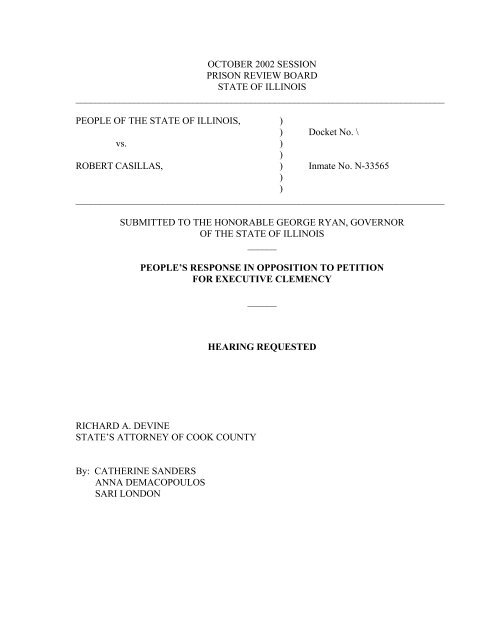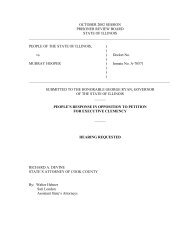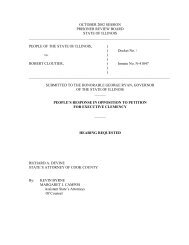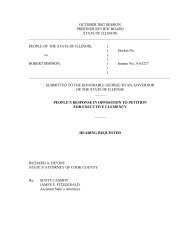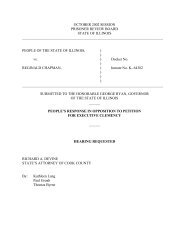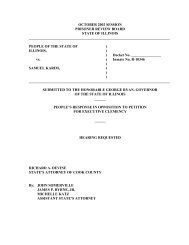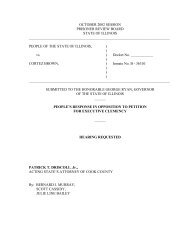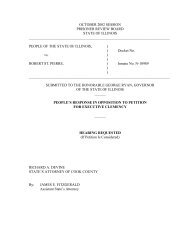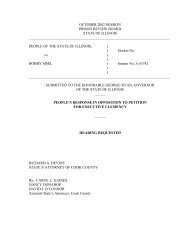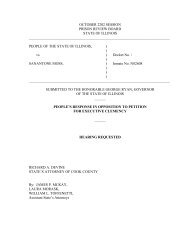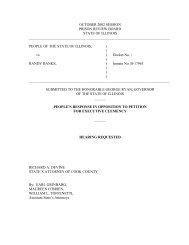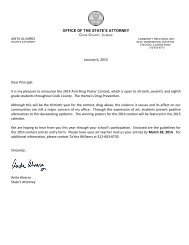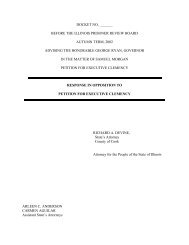Robert Casillas - Cook County State's Attorney
Robert Casillas - Cook County State's Attorney
Robert Casillas - Cook County State's Attorney
Create successful ePaper yourself
Turn your PDF publications into a flip-book with our unique Google optimized e-Paper software.
OCTOBER 2002 SESSION<br />
PRISON REVIEW BOARD<br />
STATE OF ILLINOIS<br />
____________________________________________________________________________<br />
PEOPLE OF THE STATE OF ILLINOIS, )<br />
) Docket No. \<br />
vs. )<br />
)<br />
ROBERT CASILLAS, ) Inmate No. N-33565<br />
)<br />
)<br />
____________________________________________________________________________<br />
SUBMITTED TO THE HONORABLE GEORGE RYAN, GOVERNOR<br />
OF THE STATE OF ILLINOIS<br />
______<br />
PEOPLE’S RESPONSE IN OPPOSITION TO PETITION<br />
FOR EXECUTIVE CLEMENCY<br />
______<br />
HEARING REQUESTED<br />
RICHARD A. DEVINE<br />
STATE’S ATTORNEY OF COOK COUNTY<br />
By: CATHERINE SANDERS<br />
ANNA DEMACOPOULOS<br />
SARI LONDON
OCTOBER 2002 SESSION<br />
PRISON REVIEW BOARD<br />
STATE OF ILLINOIS<br />
____________________________________________________________________________<br />
PEOPLE OF THE STATE OF ILLINOIS, )<br />
) Docket No. \<br />
vs. )<br />
)<br />
ROBERT CASILLAS, ) Inmate No. N-33565<br />
)<br />
)<br />
____________________________________________________________________________<br />
PEOPLES OBJECTION TO UNTIMELINESS<br />
OF CASILLAS’ CLEMENCY PETITION<br />
The People strenuously object to <strong>Casillas</strong>’ late and untimely filing of his Clemency<br />
Petition. The Prisoner Review Board very clearly set a time frame in which his petition was<br />
due. <strong>Casillas</strong>’ petition was due on or about August 26, 2002. Without any justification for his<br />
delay, <strong>Casillas</strong> filed his petition September 19, 2002. Due to this untimely filing, the People<br />
have had inadequate time to contact the victims, review, prepare and respond to his petition.<br />
We strongly object.<br />
Additionally, it must be noted that <strong>Casillas</strong> filed his verification and consent affidavit<br />
on August 25, 2002 obviously without having read the petition in which he verified because<br />
that petition was not filed until September 19, 2002. This is clearly wrong and violates the<br />
Rules of the Prison Review Board. As such, <strong>Casillas</strong>’ petition should be denied.<br />
Assuming, however, this Board’s and the Governor’s review of this petition despite these<br />
violations, the People respectfully respond to and strongly oppose <strong>Casillas</strong>’ petition.<br />
I<br />
1
HISTORY OF THE CASE<br />
Thirteen years ago, on February 24, 1989 <strong>Robert</strong> <strong>Casillas</strong> robbed and then fatally shot<br />
Chang Choi and Myung Choi, the owners of Key Jewelers, which was located at 6903 N. Clark<br />
Street. Defendant was arrested for those charges on July 24, 1995. (R. CL C23) <strong>Robert</strong> <strong>Casillas</strong><br />
confessed to involvement in this horrible crime but he blamed his co-defendant Guadelupe Aguilar for<br />
the shooting. (Despite <strong>Casillas</strong>’s claim that he was not the actual shooter we know from the codefendant’s<br />
statement that <strong>Casillas</strong> was in fact the actual shooter) <strong>Robert</strong> <strong>Casillas</strong> was charged by<br />
Indictment No. 95 CR 32125 with ten counts of murder for the deaths of Chang Choi and Myung Choi.<br />
(R. CL C7-C16) While awaiting trial for this case, <strong>Casillas</strong> escaped from the <strong>Cook</strong> <strong>County</strong><br />
Department of Corrections on August 21, 1995. He went to Disney World and then ultimately went to<br />
Texas where he was finally apprehended on September 27, 1995 and brought back to Chicago to stand<br />
trial.<br />
On October 24, 1996, defendant's Motion to Suppress Statements was heard. (R. 50-71)<br />
After hearing all the witnesses and argument, the trial court denied defendant's motion. (R. 71)<br />
Thereafter, <strong>Casillas</strong> and co-defendant Aguilar was tried before separate but simultaneous juries. On<br />
April 23, 1997, with the Honorable Loretta Hall Morgan presiding, <strong>Casillas</strong>' jury was selected. (R.<br />
305-470) The jury trial commenced on April 28, 1997. (R. CL C2, 475) Thereafter, on May 5, 1997,<br />
the jury found defendant <strong>Casillas</strong> guilty of two counts of murder for the shooting deaths of Chang Choi<br />
and Myung Choi. (R. 1569)<br />
On May 6, 1997 defendant's death hearing was commenced. (R. 1578-2039) Defendant<br />
had previously waived a jury for the death phase of his case. (R. 277-282) Defendant was found<br />
eligible to receive the death penalty and after hearing evidence and argument in support of<br />
2
aggravation and mitigation, the trial court sentenced defendant <strong>Casillas</strong> to death. (R. 2039) On<br />
July 7, 1997, defendant's motion for new trial and reconsideration of his sentence was denied.<br />
(Supp. R. Vol.1-10) On August 20, 1997, <strong>Casillas</strong> filed his Notice of Appeal.<br />
The Illinois Supreme Court reviewed <strong>Casillas</strong>’ trial and sentencing hearing and affirmed<br />
both his convictions and death sentence. People v. <strong>Casillas</strong>, 195 Ill. 2d 461, 749 N.E.2d 864<br />
(2000). His Petition for Rehearing was denied on June 4, 2001. Moreover, the United States<br />
Supreme Court declined to review the decision. Currently, <strong>Casillas</strong> has filed a Petition for Post-<br />
Conviction Relief which is pending in the trial court.<br />
For the reasons that follow the People of the State of Illinois respectfully request that<br />
Governor Ryan and this Board reject <strong>Robert</strong> <strong>Casillas</strong> executive clemency.<br />
3
II<br />
FACTS OF THE CASE<br />
Prior to jury selection, in front of the entire jury venire, the trial court spoke to the<br />
potential jurors. (R. 303-314,320-322,413-416) The trial court informed the jury about many<br />
fundamental concepts involved in a criminal trial. Those concepts included the burden of proof,<br />
presumption of innocence and that the indictment was not evidence of guilt. (R. 303-314,320-322,413-<br />
416) After the jury was selected and sworn but prior to hearing opening statements, the trial judge once<br />
again told the jurors that the state had the burden of proof. (R. 495,496)<br />
The evidence at trial established that February 24, 1989 was the last time James and Connie<br />
Choi saw their parents Chang Choi and Myung Choi alive. (R. 526-528) The Chois owned Key<br />
Jewelers located at 6903 N. Clark. (R. 525)<br />
Later in the evening while James Choi was watching television he saw a news report which<br />
showed his parents' store surrounded with police. (R. 526-527) When James drove to the store he saw<br />
numerous police. His father's friend informed him that his mother and father had been "gunned down".<br />
(R. 528)<br />
Police Officer Leroy Rosen first arrived at the jewelry store at approximately 5:15 p.m.,<br />
responding to a call of a holdup alarm. (R. 531) It was later determined that the holdup alarm had been<br />
activated at 6903 N. Clark by remote on February 24, 1989 at 5:13 p.m. (R. 662,669) The light was on<br />
in the store but the front door was locked. (R. 531) Other police cars responded to the scene. (R. 533)<br />
Sergeant Thomas Schaedel also responded to the call and went to the back of the store<br />
through the alley. (R. 539, 540) When he walked through the corridor he noticed small pieces of<br />
4
jewelry in the snow. (R. 541) Several pieces of jewelry were recovered by the rear of the store during<br />
the investigation. (R. 749-752) The back screen door of the store had been ripped and the back door<br />
was open. (R. 541)<br />
When Sergeant Schaedel entered the back of the store, he saw Myung Choi laying face<br />
down on the floor in a pool of blood, which was coming from her head. (R. 541) In the front of the<br />
store, Chang Choi was laying face down in a pool of blood. (R. 542) Jewelry was on the floor and<br />
cases were open. (R. 542)<br />
Detective Philip Mannion, who also went to the jewelry store, explained that you had to be<br />
buzzed in to enter the store and that something covered the windows which prevented people from<br />
looking inside the store. (R. 550, 561) The victim, Mr. Choi, was lying on the floor face down with his<br />
feet under the worktable. (R. 561) He had a gunshot wound to the right side of his head. (R. 562) Mrs.<br />
Choi was on the other side of the partition in the back part of the store. (R. 565) She was also laying<br />
face down on the floor with a gunshot wound to the right side of her head. (R. 565, 566) Spent casings<br />
were found near Mr. and Mrs. Choi's bodies. (R. 568, 569) There was a bullet hole in the partition,<br />
which divided the front and the back of the store. (R. 569,570) A bullet was later recovered on top of<br />
the ceiling tiles. (R. 756-759, 1055)<br />
The back door was open and unlocked. (R. 577) The screen door had been kicked out and<br />
the clasp on the lock of the door was intact but the chain was broken. (R. 577) This indicated that the<br />
back door had been locked. (R. 592) There was snow on the ground and the snow had been trampled<br />
on. (R. 591)<br />
Forensic Investigator Thomas J. Ginnelly of the Crime Lab Mobile Unit responded to the<br />
scene. (R. 681) He photographed the crime scene, collected firearms evidence, and checked for<br />
5
fingerprints. (R. 684,685,688,695) Specifically, cartridge casings were found near the victims bodies,<br />
a live round was found laying on top of Mrs. Choi's leg, and a right hand black leather glove was<br />
recovered. (R. 692-695) Some latent prints were recovered at the scene, which were sent to the Latent<br />
Unit Identification Section. (R. 712) The black glove did not contain any suitable prints to compare.<br />
(R. 696, 1058)<br />
On December 21, 1995, Latent Fingerprint Examiner William Kovacs examined the latent<br />
fingerprints, which were recovered on February 24, 1989 from 6903 N. Clark. (R. 969-978) Based on<br />
his comparisons of the latent prints found at the scene and co-defendant's fingerprints, Officer Kovacs<br />
determined that defendant Aguilar's fingerprints had been left at the scene. (R. 970-978) On May 9,<br />
1995, Officer Kovacs received a request from Washington State to compare photocopies of<br />
fingerprints. (R. 978-981) Based on the quality of the photocopies, Officer Kovacs was unable to<br />
make a comparison. (R. 978-981)<br />
The victims' daughter, Connie, worked at the jewelry store every Saturday. (R. 615) She<br />
would clean the counters and display the jewelry. (R. 615) She explained that approximately $15,000<br />
in wholesale value of jewelry was missing from the store. (R. 623) There was also an alarm system in<br />
the store, which included an alarm box and a remote. (R. 632)<br />
In the back room, the sofa blocked the back door, which was padlocked and had a wooden<br />
bar across it. (R. 638) The back door was never used except once when her father opened the door.<br />
(R. 639, 640) The screen did not have a rip in it. (R. 639, 640) Her father never wore glasses or gloves<br />
when he worked but he wore a magnifier. (R. 640,645)<br />
Medical Examiner Doctor Eupil Choi conducted the autopsies on Mr. and Mrs. Choi on<br />
February 25, 1989. (R. 772-795) Mr. Choi suffered a gunshot wound to the right side of his head. (R.<br />
6
777) His head was in a downward position when he was shot. (R. 780) Mrs. Choi suffered a gunshot<br />
wound to the right side of her head. (R. 789) She also had a laceration on the left backside of her head,<br />
which was caused from blunt trauma. (R. 785,786) The bullets were recovered from both victims'<br />
bodies. (R. 779,788) It was Dr. Choi's opinion that the cause of death for both victims was a gunshot<br />
wound to the head. (R. 794, 795)<br />
The parties stipulated that Firearms Examiner Gaynor received the bullets recovered from<br />
the ceiling panel and from Mr. and Mrs. Choi's heads. He examined the bullets. (R. 1057) He<br />
determined that each bullet had been fired from the same .32 caliber semiautomatic weapon. (R. 1057)<br />
Between December 1988 and February 1989, Patricia Farias allowed defendant <strong>Casillas</strong><br />
(Rush) to stay at her apartment. (R. 852-853) She had met defendant Aguilar, whom she knew as<br />
Stiletto, in January 1989. (R. 853)<br />
When Patricia woke up on February 24, 1989, she saw defendant and Aguilar in her<br />
apartment. (R. 854) She would not allow defendant to borrow her car that day. (R. 855) She went to<br />
work and she came home around 5:45-6:00 p.m. (R. 855)<br />
After work she parked her car in front of the jewelry store located at 6903 N. Clark. (R.<br />
856) She observed several police cars and officers at that location. When she tried to open the door to<br />
her apartment, the door was locked and it had been bolted on the inside. (R. 856) She knocked on the<br />
door and Aguilar opened the door. (K. 858) As she entered her apartment and went toward her<br />
bedroom, she noticed that her bedroom door was closed and locked. (R. 858) Defendant opened the<br />
door. Defendant was not usually in her bedroom. (R. 859)<br />
Once in the bedroom, Patricia noticed two large green garbage bags, black trays and jewelry<br />
on her bed. (R. 859) Patricia told defendant to leave her apartment. (R. 860) Defendant stated that<br />
7
they needed a ride. (R. 860) Patricia drove defendant and Aguilar to <strong>Casillas</strong>' sister's house. (R. 864)<br />
They brought the garbage bags and a gym bag with them. (R. 862)<br />
After driving defendant and Aguilar to his sister's house, Patricia went to her friend's house.<br />
(R. 867) Patricia told her friend that she thought defendant did something really bad. (R. 867) About a<br />
month later, Patricia received a call from defendant. (R. 867) She asked defendant, "Did you do that?"<br />
Defendant said, "I asked you not to ask me any questions, I just called to see how the kids were."<br />
(R.867)<br />
Patricia did not call the police because she was afraid. (R. 868) She finally spoke to<br />
Detective Zuley about what she knew in May 1995. (R. 868) She did not tell the detective everything<br />
until a few weeks later because she was afraid. (R. 868)<br />
On the day of the incident defendant never told her that he was afraid of "Stiletto".<br />
Defendant also never said, "I didn't have anything to do with this." (R.869) Patricia stated that back in<br />
January 1989 she had a conversation with defendant where he stated that he would like to get a gun<br />
because he had always had one. (R. 870) Patricia, however, had never seen defendant with a gun.<br />
(R.873)<br />
Paul Hernandez, defendant <strong>Casillas</strong>' brother-in-law, stated that he was home the evening of<br />
February 24, 1989, when defendant and Aguilar came to his house. (R. 939,940)<br />
Defendant and<br />
Aguilar had three bags of jewelry, which they put on the kitchen table. (R. 942) While they were in the<br />
kitchen, Aguilar said, "We ripped off a jewelry store." (R. 943, 955, 956) Defendant did not say where<br />
the jewelry came from. (R. 949) Defendant seemed to be nervous that night. (R. 950) That evening<br />
Aguilar had his shirt over his pants and was constantly adjusting his pants. (R. 953) Paul stated that he<br />
did not see defendant with a gun that night and that he did not think he had a gun. (R. 954) Defendant<br />
8
and Aguilar spent the night but left the next morning with their jewelry. (R. 946) Paul did not go to the<br />
police and did not speak to the police about that night until July 31, 1995. (R. 947)<br />
A.T.F. agent Steve Brezette testified that on April 25, 1995, he was working with a<br />
confidential informant who gave him information about the homicide which occurred February, 1989.<br />
(R. 814,815) Agent Brezette passed this information on to Detective Zuley. (R. 815,994)<br />
Detective Richard Zuley had been to the jewelry store on the evening of February 24, 1989.<br />
(R. 993) He spoke to a person named Steve Slamski who lived at 1672 W. Farwell. (R. 994)<br />
After his conversation with Agent Brezette, he looked to speak to Mr. Slamski again. (R.<br />
994) He learned that Mr. Slamski had died. (R. 994)<br />
On July 24, 1995, Detective Zuley interviewed defendant <strong>Casillas</strong>. (R. 995) Defendant was<br />
advised of his rights and was willing to talk about what happened on February 24, 1989 at Key<br />
Jewelers. (R. 999) The conversation lasted approximately twenty- five minutes. (R. 999) Thereafter,<br />
Assistant <strong>State's</strong> <strong>Attorney</strong> Alesia was notified. (R. 999) During defendant's conversation with A.S.A<br />
Alesia, defendant minimized his involvement in the crime. (R. 1000)<br />
Specifically, defendant stated that he was wearing a pair of dark colored gloves. (R. 1000)<br />
He stated that he and Aguilar first went to Key Jewelers located at 6903 N. Clark Street at 4:00 p.m. in<br />
order to "case" the place. (R. 1001) While in the store, Aguilar asked the owners about the price of a<br />
piece of jewelry. (R. 1007) Then they returned to Patty Farias' apartment where they did some cocaine.<br />
(R. 1002) Defendant told the detective that Aguilar became weird and aggressive after they did<br />
cocaine. (R. 1008) They returned to the jewelry store at 5:00 p.m.(R. 1002) Defendant stated that he<br />
knew what was going to happen when they went back to the jewelry store because he was told by<br />
Aguilar to "keep your eyes open" or "keep a look out". (R. 1002, 1014) Defendant knew that meant<br />
9
that a robbery was "going to go down". (R. 1003)<br />
Defendant also told the detective that when they returned to the store Aguilar asked to look<br />
at the piece of jewelry he had looked at earlier. (R. 1018) Defendant stated that while he was "watching<br />
out", he heard gunshots and he turned and saw Aguilar with a gun in his hand pointed at the man who<br />
was slumped over. (R. 1026)<br />
Mrs. Choi screamed and she ran toward the buzzer. (R. 1026) Mrs. Choi was dragged into<br />
the back and she was pleading for her life. (R. 1003) Defendant watched while Aguilar shot Mrs. Choi.<br />
(R. 1027) Thereafter, Aguilar grabbed up trays of gold and defendant carried eight of the trays. (R.<br />
1027) When defendant and Aguilar left the store they had to take a two by four off the door in order to<br />
exit. (R. 1004) They went down the alley, down the gangway, and across the street to Patty's<br />
apartment. (R. 1004)<br />
While in Patty's apartment, defendant and Aguilar emptied the jewelry out onto Patty’s bed.<br />
(R. 1005) The jewelry was then placed in two garbage bags. (R. 1005) When Patty came home and she<br />
knocked on the door Aguilar answered the door while defendant stayed in the bedroom with the<br />
jewelry. (R. 1005) Patty was very angry with defendant when she saw the jewelry on the bed. (R.<br />
1005) She had seen the police cars and wanted to know if defendant was responsible for what she had<br />
seen. (R. 1006) Defendant first told Detective Zuley that he went to get Patty's car but then after being<br />
confronted with the fact that Patty said she went to get the car defendant stated that she may have gone<br />
with him. (R. 1006) Defendant also told the detective about going to his brother-in-law's house. (R.<br />
1007) Defendant also admitted that he was given, "his share" by Aguilar. (R. 1007)<br />
Detective Zuley showed defendant the Chicago Police Department Daily Bulletin dated<br />
March 6, 1989. (R. 1010) Defendant identified himself and Aguilar in the bulletin that was showed to<br />
10
him. (R. 1012)<br />
On July 24, 1995, Assistant <strong>State's</strong> <strong>Attorney</strong> ("A.S.A."), Joseph Alesia was working in<br />
the felony review unit when he was assigned to go to Belmont and Western to question defendant<br />
about a double murder which had occurred on February 24, 1989. (R. 1060-1064) When he arrived at<br />
the station at 3:00 p.m. he met with Detective Zuley and then he introduced himself to defendant. (R.<br />
1062) A.S.A Alesia left the station to interview a witness and he returned to the station at<br />
approximately 8:00-9:00 p.m. (R. 1065).<br />
Thereafter, the A.S.A. spoke to defendant and advised defendant of his rights. (R. 1065)<br />
After defendant said that he understood his rights, defendant agreed to speak to A.S.A. Alesia about<br />
the double murder. (R. 1066) Defendant chose to memorialize his statement in handwritten form. (R.<br />
1067) The contents of defendant's handwritten statement were published to the jury. (R. 1079-1092)<br />
In his statement defendant admitted knowing co-defendant Aguilar (Stiletto) and said that<br />
he, defendant, was known as Rush. (R. 1081) Defendant stated that back in December 29, 1988, he<br />
moved in with a girl named Patty. (R. 1081) There was a jewelry store on Clark Street just around the<br />
corner from Patty's apartment. (R. 1081)<br />
Defendant stated that on February 23, 1989, he and Aguilar were "hanging out" and ended<br />
up at Patty's apartment. (R. 1082) The next day, after Patty would not let him borrow her car and after<br />
she went to work, he and Aguilar stayed in the apartment all day until 4:00 p.m..(R. 1082) At 4:00<br />
defendant and Aguilar went to the jewelry store located on Clark Street. (R. 1082) Defendant and<br />
Aguilar had to be buzzed into the store. (R. 1083) While in the store he and Aguilar started to look at<br />
jewelry. (R. 1083) Aguilar asked the older woman about the price of a "medal". (R. 1083) Defendant<br />
admitted that they went to the store in order to "case" it, to look for security and to see if it would be<br />
11
easy to rob. (R. 1083) Aguilar told the older woman that he would be back and they returned to Patty's<br />
apartment. (R. 1083)<br />
While at Patty's apartment, defendant did a one- inch line of cocaine and Aguilar did two<br />
one inch lines of cocaine. (R. 1083) Defendant stated, he was not intoxicated by the cocaine. (R. 1084)<br />
Defendant admitted going back to the jewelry store at 5:00 p.m. to rob it. (R. 1084) Neither defendant<br />
nor Aguilar had a mask on and only Aguilar had a knit cap on. (R. 1084)<br />
When they returned to the store only the older male and female "Korean's" were there. (R.<br />
1084) Defendant stated that after they were buzzed into the store, Aguilar told defendant to "keep his<br />
eyes open". (R. 1084) Defendant knew that "keep your eyes open" meant that something was going to<br />
happen. (R. 1084)<br />
Defendant stated that Aguilar asked to look at a piece of jewelry while defendant was by the<br />
display cases by the front "watching for anyone who was approaching during the robbery". (R. 1085)<br />
Aguilar told the man that he would take the medallion. (R. 1085) While the woman was writing up a<br />
receipt the man was working on the medallion at the buffing machine. (R. 1085) Defendant stated that<br />
he heard a pop and saw Aguilar with his arm extended with a gun in his hand pointing it at the old<br />
man's head. (R. 1085) He saw that the man was slumped down onto the machine. (R. 1085) Defendant<br />
stated that the gun was a .25 or a .32 caliber automatic. (R. 1085)<br />
Defendant then stated, the woman screamed "oh, no, oh, no, oh, no". (R. 1086) The woman<br />
ran to an alarm button and pressed it. (R. 1086) The woman also ran to the back of the store where<br />
Aguilar chased her. Defendant ran back there too. (R. 1086) Defendant stated that Aguilar held the<br />
woman by the neck and tried to shoot her. (R. 1086) She was screaming "oh, no, no". (R. 1086)<br />
Aguilar pulled the trigger but the gun jammed. (R. 1086) After Aguilar cleared the jam, a live bullet<br />
12
that had been jammed in the gun popped out. (R. 1086) Defendant stated that Aguilar then shot the<br />
woman in the head one time and the woman went down. (R. 1086)<br />
Defendant admitted that Aguilar began to empty trays of jewelry into a box and gave seven<br />
or eight trays of jewelry to defendant. (R. 1087) They went to the rear of the store and Aguilar took a<br />
two by four off the rear door and they left the store carrying the jewelry. (R. 1087) Defendant admitted<br />
that after they walked through the gangway and the alley, they went back to the apartment where<br />
defendant was staying. (R. 1087)<br />
Defendant admitted that when they returned to Patty's apartment he bolted the door and he<br />
went to Patty's bedroom and threw the trays of jewelry on the bed. (R. 1087) A few minutes later when<br />
Patty came home, she yelled for him because she could not get into her apartment. (R. 1087) When<br />
they let Patty into her apartment, she asked, "what's up, there's a lot of cops out by the store." (R. 1087)<br />
After Patty went to her room and saw the jewelry, she looked at defendant for answers. (R. 1088)<br />
Defendant admitted that he and Aguilar put the jewelry in plastic bags and told Patty that they wanted<br />
to get out of there. (R. 1088) Patty told defendant that the car was parked by the jewelry store. (R.<br />
1088) Defendant got the keys and walked to where the car was parked. (R. 1088) Defendant stated that<br />
the police were all around and he had asked a police officer, "What's going on". (R. 1088) The officer<br />
told defendant that it was a robbery and defendant then asked if anyone was hurt. (R. 1088) The officer<br />
did not know if anyone had been hurt. (R. 1088) When defendant returned with the car, Patty and<br />
Aguilar came out and Aguilar had the bags of jewelry. (R. 1088) While they were getting in the car, a<br />
police car stopped and looked at them but then left. (R. 1089)<br />
Patty drove them to defendant's sister's house. (R. 1089) Defendant and Aguilar spent the<br />
night at his sister's house. (R. 1089) Defendant claimed that Aguilar threw the jewelry trays in the<br />
13
garbage in the alley and then put the gold jewelry in a bandanna. (R. 1089)<br />
Defendant admitted that the next day Aguilar gave him a handful of gold chains, rings, and<br />
medallions from the bandanna. (R. 1089) Defendant stated that he gave it away during the next week.<br />
(R. 1089)<br />
Defendant admitted that he never saw the "Korean's" with any weapons. (R. 1089)<br />
Defendant stated that he could never forget what happened back in 1989 because he could not forget<br />
doing something like that, which he claimed meant, "robbing the jewelry store". (R. 1090) Prior to<br />
defendant's present statement, defendant never told the police what happened. (R. 1090)<br />
During defendant's statement he identified a photo of Aguilar and he identified police<br />
sketches of himself and Aguilar, which had been in a police bulletin. (R. 1090) Defendant also stated<br />
that he had been treated well and no one threatened him or made him any promises. (R. 1091)<br />
Defendant ate, drank, and used the washroom. (R. 1091) After the statement was read out loud and<br />
corrections were made, defendant signed the statement. (R. 1091.1092)<br />
At no point during the interview did defendant tell A.S.A. Alesia "his stomach was in his<br />
throat during the time he was in the jewelry store ". (R. 1093) Defendant also never said that he was<br />
"thunder struck when this robbery occurred". (R. 1093) In the beginning of defendant's statement<br />
A.S.A. Alesia described the crime as a fatal shooting and not a murder. (R. 1095) A.S.A. Alesia never<br />
told defendant that he would most likely be a witness against Aguilar and he would only be charged<br />
with armed robbery. (R. 1097, 1098) Thereafter, during the trial, defense counsel made an oral<br />
motion in limine to bar evidence of defendant's escape. (R. 1285) The trial court denied defendant's<br />
motion. (R. 1286)<br />
Thereafter, the parties stipulated that on August 21, 1995, defendant was an inmate at the<br />
14
<strong>Cook</strong> <strong>County</strong> Department of Corrections awaiting trial. (R. 1287) The evidence established that on<br />
August 21, 1995, at approximately 9:00 p.m. defendant escaped from <strong>Cook</strong> <strong>County</strong> Department of<br />
Corrections. (R. 1289-1295) After escaping, defendant received assistance from fellow Latin King<br />
gang members. (R. 1308-1325)<br />
Specifically, Victor Cervantes testified that on August 21, 1995, at approximately 9:00 p.m.<br />
he was at a party at 25th Street and Sacramento when he saw a man whom he identified as defendant<br />
standing on the corner by himself. (R. 1307, 1308) He had never met defendant before. (R. 1314) He<br />
asked defendant "what you be about?" (R. 1308) After defendant said where he was from, Cervantes<br />
invited him to join them at the party. (R. 1309) Defendant had a beer and he asked for a ride. (R. 1309)<br />
Cervantes' brother drove by and gave defendant a ride. (R. 1311, 1312) Shortly thereafter, Cervantes<br />
returned to the party and he saw a lot of police cars and helicopters with spotlights. (R. 1313)<br />
On cross-examination, Cervantes stated, even though it was not his party he took it upon<br />
himself to invite defendant. (R. 1315) He also stated, although defendant was a stranger he asked his<br />
brother to give defendant a ride. (R. 1315)<br />
After cross-examination the state asked for a side bar. (R. 1318) In accordance with a prior<br />
motion in limine to keep out evidence of gang affiliation the State had deliberately avoided mentioning<br />
defendant's gang membership. (R. 1319) On cross-examination the defense raised the issue, why<br />
would Cervantes give defendant help? (R. 1319, 1320) The court stated that because the issue had been<br />
brought out on cross-examination, the court could not preclude the State from bringing out the fact that<br />
defendant received help because he was a gang member. (R. 1320, 1321)<br />
On re-direct, Cervantes explained that when he asked defendant, "What does he be about?"<br />
that meant, was defendant in a gang? (R. 1324) Cervantes explained that defendant told him that he<br />
15
was a Latin King and defendant showed Cervantes his tatoo on his arm. (R. 1325) He invited<br />
defendant to the party and gave him a ride because defendant was a Latin King. (R. 1325)<br />
After defendant's escape, William Prybell, from the Fugitive Warrant Unit of the <strong>Cook</strong><br />
<strong>County</strong> Sheriff's Police, was one of the many assigned to locate defendant. (R. 1326, 1327) By<br />
September 27, 1995, the search exceeded the boundaries of Illinois. (R. 1329) They received<br />
information that defendant was in Pasadena right outside Houston, Texas. (R. 1329, 1330) On<br />
September 27, 1995, he went with other officers to Texas where they apprehended defendant and<br />
transported him back to Chicago. (R. 1330)<br />
After the People rested, defendant testified on his own behalf. (R. 1352-1431) Defendant<br />
testified that he was with Aguilar ("Stiletto") on February 24, 1989, and that they went to the jewelry<br />
store where Stiletto looked at jewelry but that he did not go to "case" the place or to be a look out. (R.<br />
1358-1366) Defendant claimed he was shocked when he saw Stiletto shoot the Asian man. (R. 1367)<br />
Defendant stated that after Stiletto shot the woman, defendant backed against the cut-out by the wall<br />
and fell to his knees. (R. 1368) He claimed that he felt sick and scared. (R. 1369)<br />
Defendant admitted that he was wearing gloves that day but that he did not lose a glove on<br />
that day. (R. 1371, 1413) Defendant testified that when the lady ran for the buzzer he jumped over the<br />
counter. (R. 1414) Defendant claimed he did not see Aguilar hit the woman with the gun. He did<br />
however see her get shot. (R. 1416) Defendant admitted that the gun was a .32 automatic weapon. (R.<br />
1417) Defendant did not initially accept the gold from Stiletto but after a short conversation he<br />
accepted it. (R. 1380) During his testimony defendant denied many of the things he had said in his<br />
statement. (R. 1422-1424)<br />
Defendant claimed he did not talk to the police prior to 1995 because he was afraid for his<br />
16
family. (R. 1383) Defendant claimed that when he first spoke to Detective Zuley he was told that his<br />
family could be protected. (R. 1384, 1385) Defendant claimed he had been told that he would not be<br />
charged with murder and that he would only be charged with armed robbery. (R. 1390) It was not until<br />
he was arraigned that he realized that he had been charged with murder. (R. 1393) After the card<br />
Detective Zuley had given him was taken away, he was scared. (R. 1394) He escaped from jail a week<br />
later. (R. 1394)<br />
Although defendant claimed to be afraid of co-defendant Aguilar, he allowed Patty to be<br />
alone with Aguilar when he went to get the car. (R. 1409) Additionally, he took Aguilar to his sister's<br />
house who had six small children. (R. 1420) Even when Aguilar was not near defendant while they<br />
were at his sister's house, he never left and went to the police. (R. 1421) He did not go to the police the<br />
next day when Aguilar was no longer with him. (R. 1421, 1422) Thereafter, defendant rested. (R.<br />
1444) In rebuttal, the People presented two certified copies of conviction. One was for defendant's<br />
May 23, 1984 conviction for escape and the other was defendant's July 27, 1990 conviction for felony<br />
use of a weapon. (R. 1444, 1445)<br />
Detective Zuley testified in rebuttal and stated that when he spoke to defendant July 24,<br />
1995, defendant told him that Aguilar told him to "keep your eyes open". (R. 1447) That meant that a<br />
robbery was about to go down. (R. 1447) Defendant also told the detective that both defendant and<br />
Aguilar removed the two by four from the back door. (R. 1447) Defendant was not emotional and did<br />
not cry in front of the detective. (R. 1448) Thereafter, the People rested in rebuttal. (R. 1449)<br />
Before closing argument, the jury was questioned about watching a television program. (R.<br />
1454) Juror Storslee, who watched the television show defendant was on, was excused as a juror, over<br />
defendant's objection. (R. 1485) Several jury instruction conferences were held. (R. 133-1339, 1346,<br />
17
1467-1482) I.P.I. Instructions 2.02 and 2.03 were not mentioned. (R. 1467) Prior to closing argument<br />
the trial judge told the jury that closing argument was not evidence and that the state would have an<br />
opportunity to talk in rebuttal because it was their burden to prove defendant guilty beyond a<br />
reasonable doubt. (R. 1487) The trial judge also told the jury that the court would instruct them on the<br />
law. (R. 1487)<br />
After hearing closing argument from both sides, being instructed on the law and<br />
deliberating, the jury found defendant guilty of the murders of Chang Choi and Myung Choi. (R. 1545-<br />
1566, 1569)<br />
Sentencing Hearing<br />
A death penalty hearing commenced May 6, 1997. Defendant's birth certificate, which<br />
stated that defendant was born June 16, 1964, was admitted into evidence. (R. 1579) Defendant was<br />
therefore 24 years old when he committed the murders. (R. 1579) The jury verdicts convicting<br />
defendant of the murders of Chang Choi and Myung Choi were also admitted into evidence. (R. 1580)<br />
Defendant had been convicted of murdering two people. (R. 1580) Defendant presented no evidence<br />
during the eligibility phase. (R. 1581) Thereafter, defendant was found eligible to receive the death<br />
penalty. (R. 1582)<br />
The People presented defendant's felony convictions, prior bad acts, escape, and his<br />
disciplinary reports from the Illinois Department of Corrections in aggravation. (R. 1582-1836)<br />
Victim Impact Statements of the victims' children were also presented. (R. 1838-1841, 1854-1856)<br />
Specifically, Youth Officer William Dejulio, testified he arrested defendant for burglary on<br />
September 21, 1982. (R. 1583, 1584) On September 22, 1982, defendant received three years<br />
probation. (R. 1587)<br />
18
Assistant <strong>State's</strong> <strong>Attorney</strong> Kenneth McCurry testified that in September 1983, he was an<br />
Assistant <strong>State's</strong> <strong>Attorney</strong> in Judge Schiller's courtroom. (R. 1752) In that capacity he would write a<br />
pen letter when a defendant on a case was sent to the penitentiary. (R. 1752)<br />
Two pen letters, which A.S.A. McCurry wrote were published. (R. 1754) The first letter<br />
concerned defendant attempting to burglarize a laundromat on November 19, 1982. (R. 1754) The<br />
second letter concerned defendant's attempt escape from <strong>Cook</strong> <strong>County</strong> Jail on July 27, 1983. (R. 1756)<br />
A certified copy of conviction for attempt burglary in case no. 83-6949 established that<br />
defendant was sentenced to four years in the Illinois Department of Corrections. (R. 1772) A certified<br />
copy of conviction for attempt escape in case no. 83-8410 established that defendant was sentenced to<br />
four years in Illinois Department of Corrections. (R. 1772)<br />
Chicago Police Officer Wayne Griffin was working February 11, 1983, at 11:15 p.m. when<br />
he observed defendant driving a 1969 Chevy Nova in the location of 1100 West 19th Street. (R. 1779,<br />
1780) An investigation revealed that the car belonged to Gustavo Vargas and that the car had been<br />
stolen. (R. 1781) Defendant was arrested and he admitted stealing the car. (R. 1781)<br />
Chicago Police Officer Mikolajczyk arrested defendant on May 26, 1990, for unlawful use<br />
of a weapon, no firearms owner's identification card, defacing a firearm, and a traffic violation. (R.<br />
1635-1641) On July 27, 1990 defendant pled guilty to unlawful use of a weapon and received three<br />
years in the Illinois Department of Corrections. (R. 1642)<br />
Chicago Police Officer William Soraghan testified that on September 16, 1991 he was<br />
investigating a shooting, which had occurred on September 15, 1991. (R. 1613) The victim Artemio<br />
Garcia had been shot in the head and he had stab wounds on his face and arms. (R. 1614) During the<br />
investigation he spoke to Leon Jones. (R. 1614) On September 16, 1991 he spoke to Jerry Dewange<br />
19
who lived directly across the street from where the incident occurred. (R. 1615) Mr. Dewange told him<br />
that on September 15, 1991 some "Mexicans" were drinking in the parking lot. (R. 1616) He was<br />
looking out his basement window and heard a disturbance across the street. (R. 1616) He saw a group<br />
of Latin Kings approach the "Mexicans" and they started a fight. (R. 1616, 1617) When the<br />
"Mexicans" were winning the Latin Kings fled. (R. 1617) A couple of minutes later the Latin Kings<br />
returned to the scene of the fight in a car. (R. 1617) One of the Latin Kings had a gun in his hand and<br />
shot one of the "Mexican's". (R. 1618) Mr. Dewange described the car as a brown Buick Regal where<br />
the hood of the car was a different color. (R. 1618) The hood of the car and the side of the car had gray<br />
primer. (R. 1618)<br />
On September 16, 1991, Officer Soraghan saw the vehicle, which matched the description<br />
he had been given, coming out of the alley at the same location the man had been shot the day before.<br />
(R. 1618, 1622) Defendant was the driver of the car. (R. 1619) Defendant had scratches on both sides<br />
of his cheeks and on his neck. (R. 1619, 1622) Defendant was placed under arrest for the shooting of<br />
Artemio Garcia. (R. 1619) Defendant denied involvement in the shooting. (R. 1620)<br />
The witnesses were called to the station. (R. 1620) A line-up was conducted. Defendant<br />
was the only Latin King the officer knew in the line-up. (R. 1620, 1621) The four or five witnesses<br />
who viewed the line-up did not make an identification during the line-up. (R. 1621) After the line-up,<br />
Mr. Dewange told the officer "you know I can't identify the Latin Kings." (R. 1621) He said that he<br />
lives in the neighborhood with Latin Kings, they know who he is and he is the only black man in the<br />
neighborhood. (R. 1621) He said that they would kill him. (R. 1621) The victim could not be<br />
interviewed because he was in surgery at the time. (R. 1624) As a result of the shooting the victim is a<br />
quadriplegic. (R. 1624)<br />
20
Officer Soraghan believed that two of the witnesses who viewed the line-up were black. (R.<br />
1625) In the police report the car in question was described as a brown, two door Olds with gray<br />
primer on the doors. (R. 1627) The photo of defendant's car showed that there was gray primer on the<br />
hood and not on the door. (R. 1628)<br />
Detective George Tracy testified that on October 21, 1991, he was assigned to<br />
investigate a shooting, which occurred in the alley of 2410 South Drake. (R. 1661) The victim,<br />
Gerardo Gonzalez, (Ya-Yo), had suffered a gunshot wound to his right eye. (R. 1662-1665) He later<br />
died from his injuries. (R. 1732)<br />
Detective Tracy spoke to Jaime Garcia who lived at 2404 South Drake. (R. 1669) He had<br />
heard a gunshot. (R. 1669) Jaime Garcia told the detective that he had looked in both directions down<br />
the alley and when he looked north he saw two Hispanic males running north in the alley between<br />
Central Park and Drake. (R. 1670)<br />
On October 22, 1991, Area 4 received an anonymous phone call concerning the shooting.<br />
(R. 1670) The information was that the victim had been shot as a result of a drug rip off. (R. 1671)<br />
Two males, one hispanic teenager, Jazz, and another male, Slim, were named. (R. 1671)<br />
Officers Soraghan and Esparza assisted in the investigation. (R. 1671) Jazz was Martel<br />
Gomez and Slim was Zadell Calelzadon. (R. 1671) On October 28, 1991 the detective had a<br />
conversation with Officers Esparza and Sorghan concerning Javier Chavez. (R. 1672) Thereafter,<br />
Chavez was taken to the Blue Island Police Station. (R. 1672) The detective had received information<br />
that some of the participants in the crime were from Blue Island and they were Latin Kings. (R. 1672)<br />
Chavez identified two Latin Kings from Blue Island, Jaime Alvarez (Flaco) and <strong>Robert</strong> Lopez. (R.<br />
1672, 1673)<br />
21
When Chavez was brought to Area 4 police station he did not originally mention<br />
defendant's name. (R. 1673) When defendant's name was mentioned Chavez began to shake<br />
uncontrollably and he denied knowing a person named Rush. (R. 1673)<br />
After the detective told Chavez that he had spoken to Alvarez, Chavez admitted that he<br />
knew defendant (Rush). Chavez explained that when he was standing on 24th Street, after he heard the<br />
gunshot in the alley, he had seen defendant run northbound out of the alley carrying a gun. (R. 1674)<br />
He stated that he had only known defendant (Rush) a few months. (R. 1674)<br />
On October 29, 1991, Detective Tracy requested assistance from Assistant <strong>State's</strong> <strong>Attorney</strong><br />
Matt Mahoney concerning the shooting death of Mr. Gonzalez. On July 28, 1992 defendant's trial for<br />
this incident commenced before Judge Karnezis. (R. 1675) Chavez testified at defendant's trial. (R.<br />
1675) (<strong>Casillas</strong> was convicted by a jury for the murder of Geraldo Gonzalez but his conviction was<br />
reversed and remanded by the Appellate Court due to certain evidence that was improperly given to<br />
the jury during their deliberation) Approximately a month after the trial, Chavez was shot six or seven<br />
times. (R. 1676) At the time Chavez was shot, defendant was in custody. (R. 1678) The detective<br />
never found out who shot Chavez. (R. 1680)<br />
Assistant <strong>State's</strong> <strong>Attorney</strong> Matt Mahoney (A.S.A Mahoney) testified that he was working<br />
Felony Review October 29, 1991, when he was called to Area 4 police station concerning the fatal<br />
shooting of Gerardo Gonzalez. (R. 1684) He spoke to Javier Chavez that day and prepared Chavez's<br />
handwritten statement. (R. 1684) That statement was published. (R. 1686-1699)<br />
A.S.A. Mahoney also spoke to Jaime Alvarez who was in custody for the shooting. (R.<br />
1690) A.S.A. Mahoney took a court reported statement from Alvarez. (R. 1690) That statement was<br />
also published. (R. 1691-1708)<br />
22
A.S.A. Mahoney also spoke to Martel Gomez who gave a court reported statement. (R.<br />
1709) That statement was also published. (R. 1709-1719)<br />
After all the statements were taken, an arrest warrant was issued for defendant<br />
concerning the murder of Gerardo Gonzalez. (R. 1722)<br />
Chicago Police Officer <strong>Robert</strong> Lenihan testified that from October 28, 1991, to January 8,<br />
1992, he sought to execute an arrest warrant for defendant for the charge of murder. (R. 1735) On<br />
January 8, 1992, at approximately 8:30 p.m., Officer Lenihan observed a blue sports car parked in an<br />
alley. (R. 1736) When the officer approached the car he saw defendant in the front passenger seat. (R.<br />
1737) Officer Lenihan told defendant he was under arrest. (R. 1738) Defendant told the officer,<br />
"You're going to have to shoot me, motherfucker. You're going to have to kill me." (R. 1739)<br />
Defendant told the driver to start the car but the driver listened to the officer and left his hands on the<br />
dashboard. (R. 1739) Defendant pulled the car door closed. The officer saw defendant reach down<br />
toward the floor and he thought defendant had a gun. (R. 1739) Defendant said, "You're going to have<br />
to shoot me, you're going to have to kill me or I'm going to kill you." (R. 1740) Defendant ran toward<br />
the officer and then ran down the alley. (R. 1740, 1741) After a chase and receiving assistance,<br />
defendant was apprehended and taken into custody. (R. 1743) Defendant continued to say, "You are<br />
going to have to shoot me, you're going to have to kill me." (R. 1743) A weapon was never recovered.<br />
(R. 1747)<br />
Evidence concerning the apprehension of defendant after he escaped from <strong>Cook</strong><br />
<strong>County</strong> Correctional Center was also presented in aggravation. Specifically, Detective Larry Savitsky<br />
and Carl Mitchell, of the Harris <strong>County</strong> Sheriff's Department in Houston Texas, were working as part<br />
of the Gulf Coasts Violent Offender Task Force on September 22, 1995. (R. 1590, 1599) They assisted<br />
23
in apprehending defendant who had escaped from <strong>Cook</strong> <strong>County</strong> Jail. (R. 1590, 1599) They had been<br />
unsuccessful with three different locations they had targeted in the search for defendant. (R. 1591)<br />
Finally, Detective Savitsky had received information from a confidential informant. (R. 1592) The<br />
address he had been given was a known Latin King hangout. (R. 1592) Many police officers went to<br />
the given location in Pasadena. (R. 1592, 1593, 1600)<br />
Detective Mitchell went to the back of the house where he saw defendant who had gone<br />
back inside the house. (R. 1601, 1602) He later saw defendant in custody with Sergeant Duffin. (R.<br />
1602) Several weapons were recovered as a result of the execution of their warrant. (R. 1603-1608)<br />
Several items of Latin King paraphernalia were also found. (R. 1607, 1608)<br />
Jeanette Cuomo testified that on September 29, 1995, she was an Assistant <strong>State's</strong> <strong>Attorney</strong><br />
assigned to the Felony Review Unit of the <strong>Cook</strong> <strong>County</strong> <strong>State's</strong> <strong>Attorney</strong>'s Office. (R. 1827) At that<br />
time she was assigned to speak to defendant who had just been returned from Texas on an extradition<br />
warrant for escape. (R. 1828)<br />
Defendant spoke to her about the escape, which happened August 21, 1995. (R. 1829)<br />
Defendant told her that on that day he was assigned to garbage duty at the jail. (R. 1829) Defendant<br />
wanted to work that detail so he could see how he could scale the walls and fence in order to escape.<br />
(R. 1829) He planned his escape with inmate James Hallohran. (R. 1829) On that day, defendant wore<br />
his <strong>Cook</strong> <strong>County</strong> Jail uniform over clothing he received from a fellow Latin King gang member in jail.<br />
(R. 1829) The clothing he received was a black t-shirt, black pants, black socks, and black gym shoes.<br />
(R. 1829)<br />
On August 21, 1995, defendant and James Hallohran waited until dark, approximately 9:00<br />
p.m. (R. 1830) They went outside to the canister and defendant climbed the metal pipe onto a rooftop<br />
24
and then he jumped from the rooftop onto the public area outside Division One. (R. 1830) James<br />
Hallohran was behind defendant. (R. 1830) When defendant jumped onto the public area he removed<br />
his outer jail clothing. (R. 1830)<br />
After defendant removed his clothing, he ran into a sheriff. Defendant responded briefly to<br />
the sheriff and acted as if nothing was wrong. (R. 1831) At that time, James Hallohran was caught.<br />
(R. 1831)<br />
Defendant walked past a guard house and nodded to another correctional officer. (R. 1831)<br />
Defendant then walked out onto the city street. (R. 1831)<br />
Defendant told the Assistant <strong>State's</strong> <strong>Attorney</strong> he was able to leave the Chicago-land area<br />
because he had help from fellow Latin King Gang members. (R. 1831) He received $1,000 from<br />
fellow gang members and then he drove to Disney World and Epcot Center. (R. 1831) Thereafter, he<br />
went to Houston Texas. (R. 1832) Defendant tried to cross the border into Mexico on several<br />
occasions but because he did not have the proper papers he was unable to cross the border. (R. 1832)<br />
He even tried to bribe a guard at the border. (R. 1832)<br />
Defendant told Ms. Cuomo that he did not become a Latin King until 1984 when he was 18<br />
years old and was sent to Stateville. (R. 1832) During his conversation with the Assistant <strong>State's</strong><br />
<strong>Attorney</strong>, defendant was very self-confident and proud of his gang membership. He even showed her<br />
his gang tattoos and described what they meant. (R. 1833)<br />
Defendant told Ms. Cuomo that he enjoyed life in Stateville, where he had a television, a<br />
microwave oven, a grill, and a skillet in his cell. (R. 1833) He said that he cooked with fresh groceries<br />
and that everyday he made himself corn tortillas and beans and rice. (R. 1833) He also told her that he<br />
enjoyed spaghetti and would often call his foster mother for recipes. (R. 1833)<br />
25
Defendant had access to a file, which he paid $40 dollars for. (R. 1833) He used that file to<br />
make shanks. (R. 1833) He also told Ms. Cuomo that he purchased a beeper for $150 from a prison<br />
guard.<br />
Defendant spoke about an incident where he and other gang leaders had a meeting with<br />
rival gang leaders where they invoked a code of silence in the prison. (R. 1834) The people at the<br />
meeting were known as the council. (R. 1834) The code of silence was a restriction on all gang<br />
members from "ratting" on each other to the police or the <strong>State's</strong> <strong>Attorney</strong>s. (R. 1834) This code was<br />
to inhibit the police from making arrests and to inhibit <strong>State's</strong> <strong>Attorney</strong>s from effectively prosecuting<br />
cases. (R. 1834) Violators would be dealt with by the use of violence. (R. 1838)<br />
As a gang member, defendant received various toiletries, Reebok gym shoes, and clothing<br />
from other Latin King Gang members in jail. (R. 1838) He had received a pair of gym shoes from the<br />
film director Oliver Stone who had filmed the movie, Natural Born Killers, in Stateville. (R. 1838)<br />
Those shoes were the ones that he wore when he escaped from <strong>Cook</strong> <strong>County</strong> Jail. (R. 1838)<br />
Defendant's statement to the Assistant <strong>State's</strong> <strong>Attorney</strong>s was never reduced to handwritten<br />
form. (R. 1836) Defendant was never questioned as to why he escaped. (R. 1836)<br />
Investigator Prybell, who was one of the officers who went to Texas in order to find<br />
defendant on the escape warrant, testified that defendant told him that he trains every day to escape. (R.<br />
1849) Defendant said that he runs, lifts weights, and said that his whole day revolves around how he<br />
can escape from institutions. (R. 1849) Defendant also had a conversation with Captain Panush of the<br />
Department of Corrections about his possible punishment. (R. 1847) Defendant told the captain that he<br />
would do anything necessary to get out of that punishment. (R. 1847)<br />
Chicago Police Officer Salvador Esparza testified about information concerning the Latin<br />
26
King Street Gang and her specific knowledge concerning defendant's rank in the gang. (R. 1643-1657)<br />
She explained that the various rankings even exist in the penitentiary and within <strong>Cook</strong> <strong>County</strong> Jail. (R.<br />
1646) The rankings consist of a regular soldier at the bottom, the Enforcers, the Inca, and the Crown<br />
Counsel. (R. 1647) Officer Esparza had had specific information about the Latin Kings and defendant<br />
since 1988. (R. 1649) Officer Esparza knew defendant's nickname was Rush and that R stood for<br />
Royalty. (R. 1650) In September 1991, Officer Esparza saw the tattoos on defendant's body. (R.<br />
1650) Defendant has his name on his left shoulder. (R. 1651) He also has a lion king with a crown on<br />
his forearm. That means kings of the jungle. (R. 1651) That tattoo relates to the enforcement he has to<br />
conduct to watch over his faction of Kings. (R. 1651) Defendant has a tattoo on his right arm of a lion<br />
with a crown on top of his hand. (R. 1651) That tattoo means a high powered enforcer. (R. 1652) On<br />
his right forearm is the name of one of his fellow gang members that had passed away. (R. 1652)<br />
Defendant has a tattoo on his back, which is a skeleton sitting on a throne. That tatoo indicates King<br />
Rush who has a high rank in the organization. (R. 1653) An enforcer has to act out violent crimes and<br />
acts of violent punishment to either his own members or to opposing gang members. (R. 1655) The<br />
enforcer has power and recognition, and other members look up to the enforcer. (R. 1656) In the<br />
penitentiary, an enforcer could obtain weapons and could conduct punishment, and could receive<br />
benefits such as food or getting different types of jobs. (R. 1651)<br />
Several witnesses testified concerning defendant's behavior while in custody. (R. 1759-<br />
1825)<br />
Correctional Officer John Shury was involved in an altercation with defendant on<br />
November 18, 1995. (R. 1761) Defendant struck Officer Shury. (R. 1762) Defendant also struck<br />
Lieutenant Howell. (R. 1762, 1769)<br />
27
Compliance Administrator for <strong>Cook</strong> <strong>County</strong> Jail, Ronald Hinton, is responsible for<br />
maintaining disciplinary reports on inmates. (R. 1774) The disciplinary reports concerning defendant<br />
were published. (R. 1775, 1776) On one occasion defendant failed to have on proper D.O.C. pants and<br />
claimed he did not have to listen. (R. 1776) On another occasion, two handcuff keys and razor blades<br />
were found in defendant's cell. (R. 1776)<br />
Sergeant Edward Brudnicki testified that he used to work for Stateville Correctional Center<br />
and that on March 2,1984, he was working as a Will <strong>County</strong> Sheriff's Police Officer. (R. 1783) He<br />
received information on that day that a person escaped from Joliet State prison. (R. 1784) At 11:14<br />
p.m. he received information that someone in a jail uniform was inside Club 99. (R. 1784) When<br />
Sergeant Brudnicki entered the club he found defendant standing by the phone. (R. 1786) Defendant<br />
was arrested. (R. 1790) When defendant was searched a screwdriver was recovered. (R. 1791)<br />
Superintendent <strong>Robert</strong> Griffin explained that he was in charge of two cell houses at<br />
Stateville, one of which is the house, which holds the worst level inmates. (R. 1792) Since 1986 he has<br />
had several contacts with defendant. (R. 1795) He had written up several disciplinary reports<br />
involving defendant. (R. 1797-1800) Defendant was written up for making threats to an officer; he<br />
was observed trying to break into the laundry gate with a "prybar", the prybar was recovered from<br />
defendant; defendant was also found in possession of a nine inch shank. (R. 1797-1800)<br />
Defendant's nickname at Stateville was Houdini because he had escaped a couple of times.<br />
Defendant's reputation among other officers at Stateville was that he was an enforcer and that he was<br />
known to carry out "hits" for his gang. (R. 1802) He was also known to carry weapons. (R. 1802) It<br />
was Superintendent Griffin's opinion that out of all the different inmates he had known at Stateville he<br />
would rate defendant within the top five for being a problem for his safety and the safety of other<br />
28
people within the institution. (R. 1803)<br />
Lyla Coches, the Chief Record Officer for Illinois Department of Corrections, testified she<br />
was the keeper of records for all disciplinary reports for inmates located in State institutions. (R. 1811)<br />
She testified concerning the disciplinary reports filed against defendant. (R. 1812-1826)<br />
At the conclusion of aggravation, the victim's son, James Choi, prepared a victim impact<br />
statement which was published. (R. 1838-1841) The victim impact statement of Connie Choi, the<br />
victims' daughter, was also published. (R. 1854-1856)<br />
Defendant presented several witnesses in mitigation. (R. 1868-1982) Several correctional<br />
officers from Stateville and <strong>Cook</strong> <strong>County</strong> testified that defendant did not pose a disciplinary problem<br />
for them. (R. 1868-1891, 1940-1949) Captain Morgan from Stateville did not check defendant's<br />
records before he testified on defendant's behalf. (R. 1874) Officer Sandoval, from <strong>Cook</strong> <strong>County</strong> Jail,<br />
also testified that defendant told him if he got the opportunity to escape again he would. (R. 1887)<br />
Neither Officer Panush nor Officer Sandoval found out how defendant gained possession of the keys to<br />
his shackles and handcuffs. (R. 1891, 1948)<br />
Defendant's sister Alvina <strong>Casillas</strong> and his brother Emmanuel <strong>Casillas</strong> testified on<br />
defendant's behalf. (R. 1911-1939, 1953-1973) They described defendant's childhood. After their<br />
father was kicked out of the house by their mother, defendant and his brothers and sisters were beaten,<br />
hardly fed, not sent to school, and they did not have a proper place to sleep. (R. 1913-1920, 1953-<br />
1960) The children were removed from their mother's home in 1975 when defendant was ten years old.<br />
(R. 1918) Despite their horrible childhood defendant's sister, who is now married with seven children,<br />
has never hit her children. (R. 1931) His brother Emmanuel never killed or hurt anyone as a result of<br />
their childhood. (R. 1968, 1970)<br />
29
Don Etzig, who was defendant's foster parent in the early 1980s, testified on defendant's<br />
behalf. (R. 1896-1906) Defendant followed his rules and was never disrespectful or abusive to him. (R.<br />
1901, 1905) Defendant coached Little League for him. (R. 1903)<br />
Thereafter, defendant tendered the transcript of Javier Chavez's trial testimony from the<br />
Gerardo Gonzalez murder trial. (R. 1980-1983) Defendant rested in mitigation. (R. 1982)<br />
After hearing all the evidence and arguments in support of aggravation and mitigation, the<br />
trial court sentenced defendant on June 18, 1997. (R. 2033-2039) After careful consideration of all the<br />
evidence, the trial court held that it did not find any mitigation sufficient to preclude the imposition of<br />
the death penalty. (R. 2039) Thereafter, defendant was sentenced to death. (R. 2039) On July 7, 1997,<br />
defendant's Motion for New Trial and to Reduce Sentence was denied. (Supp.R. Vol. 1 4-10) On<br />
August 20, 1997, defendant filed his Notice of Appeal.<br />
30
III<br />
REASONS FOR DENYING THE PETITION<br />
A unanimous jury found <strong>Robert</strong> <strong>Casillas</strong> guilty, beyond a reasonable doubt, for the fatal<br />
shooting of Chang Choi and Myung Choi. The Honorable Loretta Hall Morgan, who presided over<br />
the long and extensive pre-trial motions and the trial, agreed with the jury’s verdict. <strong>Casillas</strong>, who<br />
could only have been sentenced to natural life without parole or death, waived a jury for<br />
sentencing. During the aggravation phase of the death hearing, the People presented a plethora of<br />
aggravating evidence against <strong>Casillas</strong>. <strong>Casillas</strong> has an extensive criminal background, is an<br />
admitted enforcer for the Latin Kings Gang, is an extreme flight risk (<strong>Casillas</strong> was convicted for<br />
attempt escape from <strong>Cook</strong> <strong>County</strong> Jail in 1983, he escaped from Joliet State Prison in 1984 and he<br />
escaped from <strong>Cook</strong> <strong>County</strong> Correctional while he was awaiting trial in August 1995.), and he has<br />
many disciplinary infractions both from before and after he has been incarcerated on this case. In<br />
fact, <strong>Casillas</strong>’ nickname from Stateville is Houdini because of his history of escaping. <strong>Casillas</strong><br />
admits that he spends his whole day running and lifting weights in preparation to escape.<br />
Superintendent Griffin testified that out of all the different inmates he had known at Stateville he<br />
would rate <strong>Casillas</strong> within the top five for being a problem for his safety and the safety of other<br />
people within the institution.<br />
The trial judge took her job very seriously when sentencing <strong>Casillas</strong>. <strong>Casillas</strong> was found<br />
eligible under the multiple murder eligibility factor. Thereafter, based on the extensive<br />
aggravating evidence and despite mitigation, which was presented, the trial court came to the only<br />
proper conclusion. The trial judge held that she could not find any mitigation sufficient to preclude<br />
the imposition of the death penalty. Based on the evidence presented both at trial and at the<br />
31
sentencing hearing and the fact that <strong>Robert</strong> <strong>Casillas</strong> is such a flight risk one must ask this question<br />
concerning the death penalty, If not <strong>Robert</strong> <strong>Casillas</strong>-then who? Even though <strong>Casillas</strong> never gave<br />
any consideration or mercy to the Chois and their family, he now asks for mercy. The People for<br />
the following reasons strongly oppose <strong>Casillas</strong>’ petition for clemency.<br />
Introduction<br />
Petitioner asserts that he is entitled to clemency because he did not receive the benefit of<br />
the changes to the Illinois capital sentencing system, which have recently been adopted, proposed<br />
or enacted. By relying upon a laundry list of new Supreme Court Rules, statutes and proposals<br />
from the Governor’s Commission on Capital Punishment, which were not available at the time of<br />
his trial, petitioner claims that his trial (as well as that of every other capital defendant in Illinois)<br />
was by definition fundamentally unfair. However, the Illinois Supreme Court has expressly<br />
rejected the claim “that every capital trial has been unreliable and that all appellate review has been<br />
haphazard” (People v. Hickey, ___ Ill. 2d ___, 2001 Ill. LEXIS 1080 at *57 (No. 87286 September<br />
27, 2001)). Rather, the Court held that the additional safeguards included in its rules governing<br />
capital cases are not retroactively applicable because they “function solely as devices to further<br />
protect those rights given to defendants by the federal and state constitutions” and that “[a]<br />
violation of procedures designed to secure constitutional rights should not be equated with a denial<br />
of those constitutional rights.” Id. at *63, 64.<br />
Thus, the fact that the Court, the General Assembly and the Governor’s Commission<br />
have endeavored to improve the process does not mean that an injustice would result simply<br />
because the recent changes were not applied retroactively to petitioner’s case. Instead, a true<br />
injustice would only result if it were reflexively determined that petitioner’s trial was<br />
32
fundamentally unfair without any examination of the proceedings themselves. It is telling,<br />
however, that petitioner has not even attempted to demonstrate how the recent changes would have<br />
affected the outcome of the proceedings. Moreover, petitioner ignores the fact that every court<br />
which has examined the proceedings in his case determined that they were fundamentally fair and<br />
that he was not unduly prejudiced in any manner.<br />
Supreme Court Rules<br />
Petitioner asserts that he is entitled to clemency because the new Supreme Court Rules<br />
governing capital cases were not applicable to his proceedings. However, the Illinois Supreme<br />
Court has clearly held that the amendments to its rules are not retroactively applicable. Hickey,<br />
2001 Ill. LEXIS 1080 at *65.<br />
<strong>Casillas</strong> Claims That He Lacked An <strong>Attorney</strong> Who Was A Member Of The Capital Trial Bar.<br />
<strong>Casillas</strong> asserts that he lacked an attorney who was a member of the Capital Litigation<br />
Trial Bar. The Capital Litigation Trial Bar, which <strong>Casillas</strong> talks about was established by the<br />
Illinois Supreme Court in 2000. However, the Illinois Supreme Court has clearly stated that the<br />
amendment to its rules are not retroactively applicable. Hickey, 2001 Ill Lexis 1080 at *65.<br />
Nevertheless, <strong>Casillas</strong> was zealously represented by two very experienced defense attorneys, both<br />
of which have handled numerous murder trials and other serious felony trials. <strong>Casillas</strong> was<br />
represented by George Nicols, who was a prominent member of the Multiple Defendant Task<br />
Force of the <strong>Cook</strong> <strong>County</strong> Public Defenders Office and George Grezeka, who was part of the<br />
Murder Task Force of the Public Defenders Office. Both attorneys worked in very specialized units<br />
in the Public Defenders Office, which have only highly experienced trial attorneys. Both attorneys<br />
had significant experience in litigating capital cases. A review of the Supreme Court’s Capital<br />
33
Litigation Trial Bar roster reveals that George Grezeka has been approved by the Court to try<br />
capital cases. George Nicols has since retired from the Public Defender’s Office but he certainly<br />
would qualify for the Capital Litigation Trial Bar. It is clear that even though the Supreme Court’s<br />
Rules governing capital cases are not retroactively applicable to <strong>Casillas</strong>’s proceedings, it is clear<br />
that the defense attorneys in petitioner’s trial were well qualified to engage in capital litigation.<br />
<strong>Casillas</strong> claims that his attorneys made certain errors in judgement. He first claims that<br />
the jury heard that <strong>Casillas</strong> was a member of a street gang when counsel asked a witness, a total<br />
stranger but a fellow Latin King gang member, why he gave <strong>Casillas</strong> help when he escaped from<br />
<strong>Cook</strong> <strong>County</strong> Jail, thereby opening the door that <strong>Casillas</strong> was a gang member. Defense counsel’s<br />
question to the witness was not an error in judgement it was trial strategy to suggest that the<br />
witness’s testimony was not credible. The Illinois Supreme Court in affirming <strong>Casillas</strong>’ conviction<br />
held that the gang evidence was properly admitted to rebut the suggestion that the witness was not<br />
credible People v. <strong>Casillas</strong>, 195 Ill. 2d at 483. Moreover, <strong>Casillas</strong> did not raise ineffective<br />
assistance of counsel regarding this trial tactic. The Illinois Supreme Court nevertheless rejected<br />
<strong>Casillas</strong>’ other attempts of trying to blame his trial attorneys for ineffective assistance.<br />
<strong>Casillas</strong> also tries to blame his trial counsels for the inadvertent mistake which occurred<br />
at the end of trial where the jury was not giving the written and oral instruction concerning the<br />
burden of proof and presumption of innocence. This issue has already been decided and rejected by<br />
the Illinois Supreme Court. See, <strong>Casillas</strong>, 195 Ill. 2d at 473-481.The Illinois Supreme Court found<br />
that the jury was adequately informed about the burden of proof and the presumption of<br />
innocence.. Id. at 474. The Court’s decision was based on the extensive instruction given to the<br />
potential jurors during voir dire and prior to closing arguments, the written instructions actually<br />
34
tendered to the jury, and the statements made by the attorneys during closing arguments. Id. at 475-<br />
479.Moreover, the Illinois Supreme Court also held that the evidence of <strong>Casillas</strong>’ guilt was<br />
overwhelming. Id. at 478. The Illinois Supreme Court also reject <strong>Casillas</strong>’ claim that trial counsel<br />
was ineffective for failing to tender the instructions or object to the omitted instructions. Id. at 481.<br />
The Court found that counsel was not ineffective because the outcome of the trial would not have<br />
been different and because <strong>Casillas</strong> was not prejudiced. It is clear that <strong>Casillas</strong> is not entitled to<br />
clemency.<br />
Videotaping<br />
Petitioner also seeks clemency because his statement where he inculpated himself was<br />
admitted into evidence even though it was not videotaped, and points out that under the Governor’s<br />
Commission’s proposals both statements and the interrogations leading up to them should be<br />
videotaped. What petitioner fails to recognize is that neither the Commission nor the governor<br />
himself call for the suppression of a statement simply because it was not videotaped. Rather, even<br />
under the Governor’s proposed legislation (HB3717 & HB2058), such statements will still be<br />
admissible if the trial court finds that it was voluntarily made after considering the totality of the<br />
circumstances. Because the trial judge expressly found that petitioner’s statement was voluntarily<br />
made when it denied his motion to suppress statements, it is clear that the failure to videotape his<br />
statement had absolutely no effect on the fairness of his proceedings. In Addition, <strong>Casillas</strong> never<br />
raised on appeal that the trial court’s ruling on his Motion to Suppress was improper. Moreover,<br />
because the jury was instructed pursuant to Illinois Pattern Instruction 3.06-3.07 to consider all the<br />
evidence when determining whether or not petitioner made the statement and how much weight it<br />
should be given, petitioner cannot complain that he was prevented from asserting at trial that his<br />
35
statement was unreliable and should not be considered.<br />
During the Aggravation Stage Of The Death Hearing, The Trial Judge Properly Considered the<br />
Fact That <strong>Casillas</strong> Was Involved In A 1992 Murder.<br />
<strong>Casillas</strong> claims that he is entitled to clemency because the trial judge at the death penalty<br />
hearing stated that he had been involved in a 1992 murder although that charge had not been<br />
resolved and the People subsequently dropped the murder charge after <strong>Casillas</strong> had been sentenced<br />
to death. The murder case, which <strong>Casillas</strong> talks about involved a shooting where the victim<br />
Gerardo Gonzalez was shot in the right eye and subsequently died from his injuries. The evidence<br />
pertaining to this murder was more than sufficiently reliable to be considered by the trial judge<br />
during aggravation. <strong>Casillas</strong> was arrested for this murder, indicted, tried by a jury with the<br />
Honorable Themis Karnezis presiding, and was thereafter found guilty and convicted of the<br />
murder. The Appellate Court however, in a Rule 23 Order reversed defendant’s conviction and<br />
remanded the case for a new trial. <strong>Casillas</strong>’ conviction was reversed only because the trial judge<br />
abused his discretion when he allowed one of the witness’ handwritten statement to go to the jury<br />
during deliberation but he did not give the jury the witness’ conflicting trial transcript, which was<br />
not available. In its decision however, the Appellate Court found that defendant was proven guilty<br />
beyond a reasonable doubt, and that the evidence supported the verdict. It is clear therefore that<br />
the evidence which had been presented during aggravation and which was thereafter considered by<br />
the judge fell within what is statutorily permissible. The evidence concerning this murder was both<br />
relevant and reliable.<br />
While the Illinois Supreme Court held that <strong>Casillas</strong> had waived this issue on appeal, they<br />
nevertheless held that even if defense counsel had objected to this evidence during sentencing the<br />
36
outcome of <strong>Casillas</strong>’ sentencing would not have been different <strong>Casillas</strong>, 195 Ill. 2d at 491-492.<br />
The Court noted that twenty-two witnesses testified for the People in aggravation, and a written<br />
statement was admitted into evidence from the twenty-third witness. In addition, to testimony<br />
regarding the murder and the other shooting that defendant was involved in, the trial court heard<br />
extensive evidence of <strong>Casillas</strong>’ criminal history, which dated back to 1982. The court further<br />
heard testimony and accepted evidence regarding <strong>Casillas</strong>’ numerous disciplinary infractions while<br />
in prison, including testimony from a guard at Stateville Prison who stated that <strong>Casillas</strong> had a<br />
reputation as a gang enforcer and hit man and was one of the “top five” worst inmates in terms of<br />
safety problems. Id. at 491. Additionally, the Illinois Supreme court noted that the trial court heard<br />
evidence of three different escape attempts, which earned <strong>Casillas</strong> the prison nickname “Houdini”.<br />
The Court further noted that the record indicated that the trial court properly considered<br />
all the factors in aggravation and placed special emphasis on the facts surrounding the instant<br />
crime, including that Mr. and Mrs. Choi were shot for apparently no reason, leaving two small<br />
children without parents. Id. at 492. The Illinois Supreme Court found that the evidence presented<br />
in aggravation was substantial.<br />
It is clear that the trial court had a phlethora of evidence, which supported sentencing<br />
<strong>Casillas</strong> to death. Whether it be the horrible crime he committed, his extensive criminal<br />
background, his disciplinary problem while he has been incarcerated, or the fact that he is an<br />
extreme escape risk, <strong>Casillas</strong> received the sentence that he deserved under the law and is not<br />
entitled to clemency.<br />
37
CONCLUSION<br />
<strong>Robert</strong> <strong>Casillas</strong> without any regard for human life went to rob Key Jewelers, which was<br />
owned by Chang Choi and Myung Choi. During the robbery Chang Choi and Myung Choi were<br />
both shot in the head. Mrs. Choi was shot while she was pleading for her life. In his confession,<br />
<strong>Casillas</strong> tried to lay all the blame on co-defendant Aguilar. Even though it is the People’s position<br />
that <strong>Casillas</strong> was the actual shooter he was nevertheless, at the very least, an active participant and<br />
held accountable for the shootings. <strong>Casillas</strong> has never shown any remorse for what he has done.<br />
<strong>Casillas</strong> not only committed this terrible crime but he has an extensive criminal background, is an<br />
extreme escape risk, and has a long history of disciplinary problems in the penitentiary.<br />
<strong>Robert</strong> <strong>Casillas</strong> is solely responsible for the position he finds himself in now.<br />
For all these reasons, the People of the State of Illinois respectfully request that this<br />
Board and Governor Ryan deny executive clemency to <strong>Robert</strong> <strong>Casillas</strong>.<br />
Respectfully submitted,<br />
RICHARD A DEVINE<br />
State’s <strong>Attorney</strong> of <strong>Cook</strong> <strong>County</strong><br />
CATHERINE SANDERS<br />
ANNA DEMACOPOULOS<br />
SARI LONDON<br />
38


